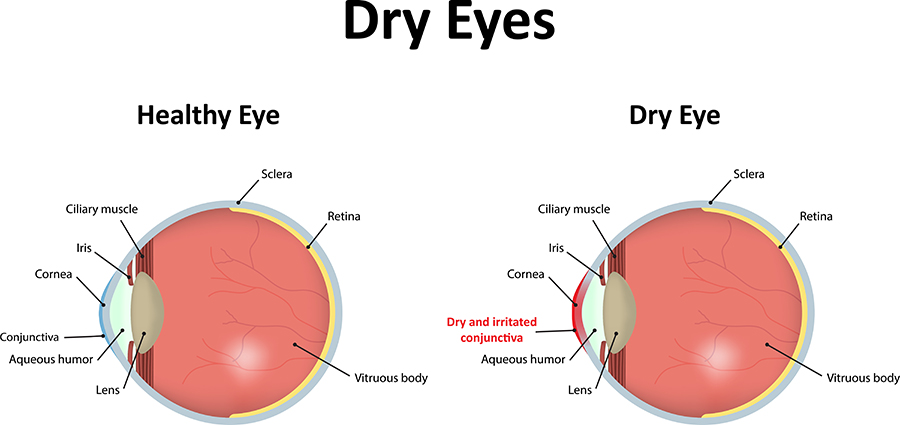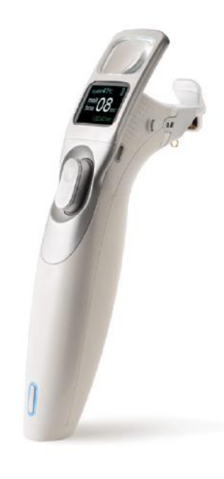
Dry eye occurs when your tear glands do not produce enough tears or the right type of tears.
The human eye has two main types of tear glands – the lacrimal gland and the meibomian gland. The lacrimal gland is responsible for emotional crying. The meibomian gland is responsible for clear vision and keeping the eye hydrated.
Dry eye disease occurs when the meibomian glands don’t work properly to create a tear film.

Causes Of Dry Eye Disease
Dry eye disease has many possible causes, including age, gender, environment, medications, systemic diseases, and poor diet.
As your eyes ages, the meibomian glands can become clogged and leads to dry eye disease. Dry eye disease is also linked to an imbalance of hormones, which is why nine out of ten dry eye sufferers are women. Environmental factors such as dry, windy, and/or smoky environments can cause dry eye disease. Computer use is also a factor in dry eye disease. The average American uses the computer for eight to ten hours per day. These long periods of sitting in front of a computer cause a person to blink less frequently, which means the meibomian glands are only producing half of the proper amount of tears.
Medications such as antihistamines, antidepressants, anxiolytics, anticholinergics, and diuretics can cause dry eye. Patients that suffer from a systemic inflammatory disease such as Sjögren’s, rheumatoid arthritis, lupus, or diabetes, also are more prone to developing dry eye disease.
Foods like candy, chips, and sweets that are high in sugar and preservatives can also contribute to dry eye disease. However, foods high in omega-3, vitamin C, vitamin E, and Vitamin D can help to decrease the occurrence and symptoms of dry eye disease.

Symptoms Of Dry Eye Disease
The symptoms of dry eye disease vary by person. Some people experience mild symptoms, such as vision that fluctuates and improves briefly with blinking, while others might experience more painful symptoms such as feeling like there may be “pins and needles” in the eyes or pain behind the eye which can cause a headache behind the eyes.
Treatments For Dry Eye Disease
Dry eye disease is a chronic condition that can’t be cured; however, there are many treatment options available to help manage the disease. Our experienced team is equipped to administer a variety of treatment options including LipiFlow, artificial tears (such as Systane® Retaine®, Refresh®, and Oasis®) eye drops, Xiidra® eye drops, and Prokera® contact lenses to promote corneal healing. For dry eye patients that wear contact lenses, scleral contact lenses are an option to help manage the disease.
iLUX® Treatments for Dry Eye Disease

iLUX® Fast and Effective
The iLUX® MGD treatment device incorporates the innovative Smart Tip Patient Interface to deliver treatment directly to the blocked meibomian glands. This device provides real time feedback to our team of experts as they administer a customized therapeutic heat and then express the oil from the glands. Now that the glands are unblocked, it will be easier for the oil to be released naturally.
Real Dry Eye Relief
The iLUX® device was shown to significantly reduce dry eye symptoms such as gritty eyes and irritation. In a clinical study, patients’ meibomian gland scores were three times better at two weeks post-treatment and four times better at four weeks, compared to baseline.
Important Information for iLUX® Device
The iLUX® Device is used to warm and compress glands in the eyelids of adult patients with a specific type of dry eye disease, called Meibomian Gland Dysfunction (MGD), also known as evaporative dry eye. Potential side effects may include eyelid/eye pain requiring stopping the treatment procedure, eyelid/eye irritation or inflammation, temporary reddening of the skin, and other eye symptoms (burning, stinging, tearing, itching, discharge, redness, feeling like there is something in the eye, changes in your vision, sensitivity to light). Ask your eye care professional for a complete list of safety information for the iLUX® Device.
If you are experiencing symptoms of dry eye, this treatment may be right for you! Please contact our office at 1-800-283-8393.
BlephEx® Treatment for Dry Eye Disease
What is BlephEx® microblepharoexfoliation (MBE) treatment?
BlephEx® is the newest, state-of-the-art treatment for dry eye disease and blepharitis. It is a simple 10 minute in-office procedure performed personally by our team of eye care experts. The procedure effectively removes bacterial biofilm (crusty substances that accumulate over the years) from the surface of the lid margin and glands that aid in the production of your natural tears. BlephEx® treatment will reduce or alleviate your chronic and debilitating symptoms. However, just like your dentist removes plaque during a routine teeth-cleaning visit, BlephEx® MBE treatments need to repeated at regular intervals depending on the severity of your disease. By eliminating the inflammatory etiology of dry eye disease and blepharitis, the overall health of the eyelid is improved, and you can then begin producing more of your own natural tears and enjoy significant relief from the chronic and irritating symptoms associated with dry eye disease and blepharitis. Please contact our office to learn more or to schedule an appointment.
There’s a Solution to Treat Your Disease… BlephEx®
If you are experiencing symptoms of dry eye, this treatment may be right for you! Please contact our office at 1-800-283-8393.
Dry Eye Self-Evaluation
Dry eye disease is one of the most frequent reasons a patient comes to us. In fact, 16 million Americans suffer from Dry Eye. If you are experiencing any symptoms of dry eye disease, you can complete a self-evaluation to determine if you have any symptoms of dry eye disease. We proudly offer dry eye treatments in South Bend, Goshen, Notre Dame, and Elkhart, IN.
Schedule your appointment online today or call 800-283-8393






